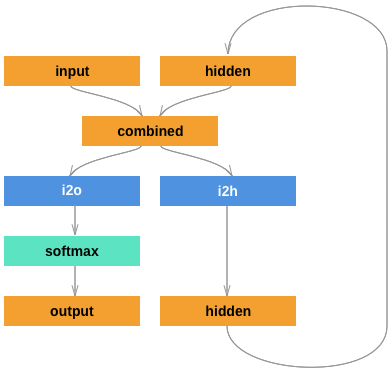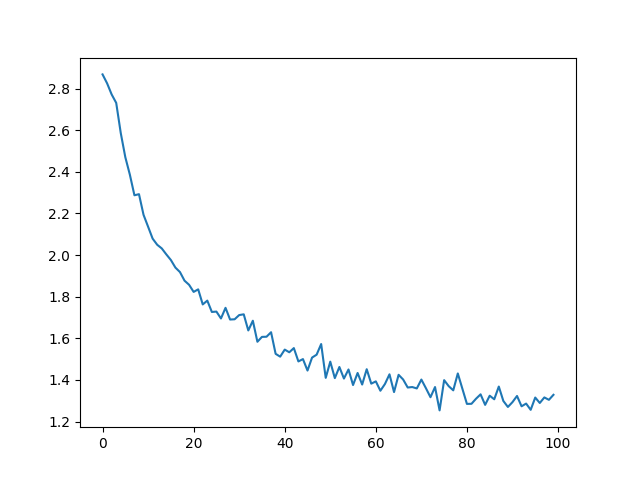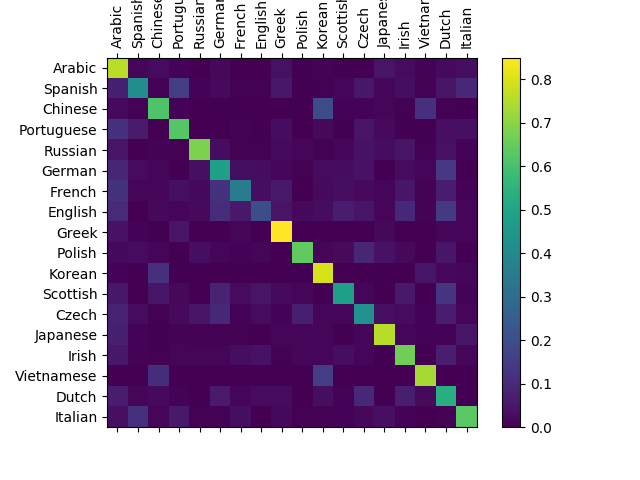Generating Names and Classifying Names with Character-Level RNN
原文地址: Generating Names with Character-Level RNN
搬运只为督促自己学习,没有其他目的。
Preparing the Data
Download the data from here and extract it to the current directory
In short, there are a bunch of plain text files data/names/[Language].txt with a name per line. We split lines into an array, convert Unicode to ASCII, and end up with a dictionary {language: [names ...]}.
from __future__ import unicode_literals, print_function, division
from io import open
import glob
import os
import unicodedata
import string all_letters = string.ascii_letters + " .,;'-"
n_letters = len(all_letters) + 1 # Plus EOS marker def findFiles(path): return glob.glob(path) # Turn a Unicode string to plain ASCII, thanks to http://stackoverflow.com/a/518232/2809427
def unicodeToAscii(s):
return ''.join(
c for c in unicodedata.normalize('NFD', s)
if unicodedata.category(c) != 'Mn'
and c in all_letters
) # Read a file and split into lines
def readLines(filename):
lines = open(filename, encoding='utf-8').read().strip().split('\n')
return [unicodeToAscii(line) for line in lines] # Build the category_lines dictionary, a list of lines per category
category_lines = {}
all_categories = []
for filename in findFiles('data/names/*.txt'):
category = os.path.splitext(os.path.basename(filename))[0]
all_categories.append(category)
lines = readLines(filename)
category_lines[category] = lines n_categories = len(all_categories) if n_categories == 0:
raise RuntimeError('Data not found. Make sure that you downloaded data '
'from https://download.pytorch.org/tutorial/data.zip and extract it to '
'the current directory.') print('# categories:', n_categories, all_categories)
print(unicodeToAscii("O'Néàl"))
Creating the Network

The category tensor is a one-hot vector just like the letter input.
We will interpret the output as the probability of the next letter. When sampling, the most likely output letter is used as the next input letter.
import torch
import torch.nn as nn class RNN(nn.Module):
def __init__(self, input_size, hidden_size, output_size):
super(RNN, self).__init__()
self.hidden_size = hidden_size self.i2h = nn.Linear(n_categories + input_size + hidden_size, hidden_size)
self.i2o = nn.Linear(n_categories + input_size + hidden_size, output_size)
self.o2o = nn.Linear(hidden_size + output_size, output_size)
self.dropout = nn.Dropout(0.1)
self.softmax = nn.LogSoftmax(dim=1) def forward(self, category, input, hidden):
input_combined = torch.cat((category, input, hidden), 1)
hidden = self.i2h(input_combined)
output = self.i2o(input_combined)
output_combined = torch.cat((hidden, output), 1)
output = self.o2o(output_combined)
output = self.dropout(output)
output = self.softmax(output)
return output, hidden def initHidden(self):
return torch.zeros(1, self.hidden_size)
Training
Preparing for Training
First of all, helper functions to get random pairs of (category, line):
import random # Random item from a list
def randomChoice(l):
return l[random.randint(0, len(l) - 1)] # Get a random category and random line from that category
def randomTrainingPair():
category = randomChoice(all_categories)
line = randomChoice(category_lines[category])
return category, line
For each timestep (that is, for each letter in a training word) the inputs of the network will be (category, current letter, hidden state) and the outputs will be (next letter, next hidden state). So for each training set, we’ll need the category, a set of input letters, and a set of output/target letters.
The category tensor is a one-hot tensor of size <1 x n_categories>. When training we feed it to the network at every timestep - this is a design choice, it could have been included as part of initial hidden state or some other strategy.
# One-hot vector for category
def categoryTensor(category):
li = all_categories.index(category)
tensor = torch.zeros(1, n_categories)
tensor[0][li] = 1
return tensor # One-hot matrix of first to last letters (not including EOS) for input
def inputTensor(line):
tensor = torch.zeros(len(line), 1, n_letters)
for li in range(len(line)):
letter = line[li]
tensor[li][0][all_letters.find(letter)] = 1
return tensor # LongTensor of second letter to end (EOS) for target
def targetTensor(line):
letter_indexes = [all_letters.find(line[li]) for li in range(1, len(line))]
letter_indexes.append(n_letters - 1) # EOS
return torch.LongTensor(letter_indexes)
For convenience during training we’ll make a randomTrainingExample function that fetches a random (category, line) pair and turns them into the required (category, input, target) tensors.
# Make category, input, and target tensors from a random category, line pair
def randomTrainingExample():
category, line = randomTrainingPair()
category_tensor = categoryTensor(category)
input_line_tensor = inputTensor(line)
target_line_tensor = targetTensor(line)
return category_tensor, input_line_tensor, target_line_tensor
Training the Network
In contrast to classification, where only the last output is used, we are making a prediction at every step, so we are calculating loss at every step.
The magic of autograd allows you to simply sum these losses at each step and call backward at the end.
criterion = nn.NLLLoss() learning_rate = 0.0005 def train(category_tensor, input_line_tensor, target_line_tensor):
target_line_tensor.unsqueeze_(-1)
hidden = rnn.initHidden() rnn.zero_grad() loss = 0 for i in range(input_line_tensor.size(0)):
output, hidden = rnn(category_tensor, input_line_tensor[i], hidden)
l = criterion(output, target_line_tensor[i])
loss += l loss.backward() for p in rnn.parameters():
p.data.add_(-learning_rate, p.grad.data) return output, loss.item() / input_line_tensor.size(0)
To keep track of how long training takes I am adding a timeSince(timestamp) function which returns a human readable string:
import time
import math def timeSince(since):
now = time.time()
s = now - since
m = math.floor(s / 60)
s -= m * 60
return '%dm %ds' % (m, s)
Training is business as usual - call train a bunch of times and wait a few minutes, printing the current time and loss every print_every examples, and keeping store of an average loss per plot_every examples in all_losses for plotting later.
rnn = RNN(n_letters, 128, n_letters) n_iters = 100000
print_every = 5000
plot_every = 500
all_losses = []
total_loss = 0 # Reset every plot_every iters start = time.time() for iter in range(1, n_iters + 1):
output, loss = train(*randomTrainingExample())
total_loss += loss if iter % print_every == 0:
print('%s (%d %d%%) %.4f' % (timeSince(start), iter, iter / n_iters * 100, loss)) if iter % plot_every == 0:
all_losses.append(total_loss / plot_every)
total_loss = 0
Plotting the Losses
import matplotlib.pyplot as plt
import matplotlib.ticker as ticker plt.figure()
plt.plot(all_losses)

Sampling the Network
To sample we give the network a letter and ask what the next one is, feed that in as the next letter, and repeat until the EOS token.
- Create tensors for input category, starting letter, and empty hidden state
- Create a string
output_namewith the starting letter - Up to a maximum output length,
- Feed the current letter to the network
- Get the next letter from highest output, and next hidden state
- If the letter is EOS, stop here
- If a regular letter, add to
output_nameand continue
- Return the final name
Note:Rather than having to give it a starting letter, another strategy would have been to include a “start of string” token in training and have the network choose its own starting letter.
max_length = 20 # Sample from a category and starting letter
def sample(category, start_letter='A'):
with torch.no_grad(): # no need to track history in sampling
category_tensor = categoryTensor(category)
input = inputTensor(start_letter)
hidden = rnn.initHidden() output_name = start_letter for i in range(max_length):
output, hidden = rnn(category_tensor, input[0], hidden)
topv, topi = output.topk(1)
topi = topi[0][0]
if topi == n_letters - 1:
break
else:
letter = all_letters[topi]
output_name += letter
input = inputTensor(letter) return output_name # Get multiple samples from one category and multiple starting letters
def samples(category, start_letters='ABC'):
for start_letter in start_letters:
print(sample(category, start_letter)) samples('Russian', 'RUS') samples('German', 'GER') samples('Spanish', 'SPA') samples('Chinese', 'CHI')
原文地址: Classifying Names with Character-Level RNN
搬运只为督促自己学习,没有其他目的。
Preparing the Data
Data is the same as the previous!
from __future__ import unicode_literals, print_function, division
from io import open
import glob
import os def findFiles(path): return glob.glob(path) print(findFiles('data/names/*.txt')) import unicodedata
import string all_letters = string.ascii_letters + " .,;'"
n_letters = len(all_letters) # Turn a Unicode string to plain ASCII, thanks to http://stackoverflow.com/a/518232/2809427
def unicodeToAscii(s):
return ''.join(
c for c in unicodedata.normalize('NFD', s)
if unicodedata.category(c) != 'Mn'
and c in all_letters
) print(unicodeToAscii('Ślusàrski')) # Build the category_lines dictionary, a list of names per language
category_lines = {}
all_categories = [] # Read a file and split into lines
def readLines(filename):
lines = open(filename, encoding='utf-8').read().strip().split('\n')
return [unicodeToAscii(line) for line in lines] for filename in findFiles('data/names/*.txt'):
category = os.path.splitext(os.path.basename(filename))[0]
all_categories.append(category)
lines = readLines(filename)
category_lines[category] = lines n_categories = len(all_categories)
Now we have category_lines, a dictionary mapping each category (language) to a list of lines (names). We also kept track of all_categories (just a list of languages) and n_categories for later reference.
Turning Names into Tensors
Now that we have all the names organized, we need to turn them into Tensors to make any use of them.
To represent a single letter, we use a “one-hot vector” of size <1 x n_letters>. A one-hot vector is filled with 0s except for a 1 at index of the current letter, e.g. "b" = <0 1 0 0 0 ...>.
To make a word we join a bunch of those into a 3D matrix <line_length x 1 x n_letters>.
That extra 1 dimension is because PyTorch assumes everything is in batches - we’re just using a batch size of 1 here.
import torch # Find letter index from all_letters, e.g. "a" = 0
def letterToIndex(letter):
return all_letters.find(letter) # Just for demonstration, turn a letter into a <1 x n_letters> Tensor
def letterToTensor(letter):
tensor = torch.zeros(1, n_letters)
tensor[0][letterToIndex(letter)] = 1
return tensor # Turn a line into a <line_length x 1 x n_letters>,
# or an array of one-hot letter vectors
def lineToTensor(line):
tensor = torch.zeros(len(line), 1, n_letters)
for li, letter in enumerate(line):
tensor[li][0][letterToIndex(letter)] = 1
return tensor print(letterToTensor('J')) print(lineToTensor('Jones').size())
Creating the Network

import torch.nn as nn class RNN(nn.Module):
def __init__(self, input_size, hidden_size, output_size):
super(RNN, self).__init__() self.hidden_size = hidden_size self.i2h = nn.Linear(input_size + hidden_size, hidden_size)
self.i2o = nn.Linear(input_size + hidden_size, output_size)
self.softmax = nn.LogSoftmax(dim=1) def forward(self, input, hidden):
combined = torch.cat((input, hidden), 1)
hidden = self.i2h(combined)
output = self.i2o(combined)
output = self.softmax(output)
return output, hidden def initHidden(self):
return torch.zeros(1, self.hidden_size) n_hidden = 128
rnn = RNN(n_letters, n_hidden, n_categories)
To run a step of this network we need to pass an input (in our case, the Tensor for the current letter) and a previous hidden state (which we initialize as zeros at first). We’ll get back the output (probability of each language) and a next hidden state (which we keep for the next step).
input = letterToTensor('A')
hidden =torch.zeros(1, n_hidden)
output, next_hidden = rnn(input, hidden)
For the sake of efficiency we don’t want to be creating a new Tensor for every step, so we will use lineToTensor instead of letterToTensor and use slices. This could be further optimized by pre-computing batches of Tensors.
input = lineToTensor('Albert')
hidden = torch.zeros(1, n_hidden)
output, next_hidden = rnn(input[0], hidden)
print(output)
As you can see the output is a <1 x n_categories> Tensor, where every item is the likelihood of that category (higher is more likely).
Training
Preparing for Training
Before going into training we should make a few helper functions. The first is to interpret the output of the network, which we know to be a likelihood of each category. We can use Tensor.topk to get the index of the greatest value:
def categoryFromOutput(output):
top_n, top_i = output.topk(1)
category_i = top_i[0].item()
return all_categories[category_i], category_i print(categoryFromOutput(output))
A quick way to get a training example (a name and its language):
import random def randomChoice(l):
return l[random.randint(0, len(l) - 1)] def randomTrainingExample():
category = randomChoice(all_categories)
line = randomChoice(category_lines[category])
category_tensor = torch.tensor([all_categories.index(category)], dtype=torch.long)
line_tensor = lineToTensor(line)
return category, line, category_tensor, line_tensor for i in range(10):
category, line, category_tensor, line_tensor = randomTrainingExample()
print('category =', category, '/ line =', line)
Training the Network
Now all it takes to train this network is show it a bunch of examples, have it make guesses, and tell it if it’s wrong.
For the loss function nn.NLLLoss is appropriate, since the last layer of the RNN is nn.LogSoftmax.
Each loop of training will:
- Create input and target tensors
- Create a zeroed initial hidden state
- Read each letter in and
- Keep hidden state for next letter
- Compare final output to target
- Back-propagate
- Return the output and loss
criterion = nn.NLLLoss() #Negative log likelihood loss It is useful to train a classification problem with C classes.
learning_rate = 0.005 # If you set this too high, it might explode. If too low, it might not learn def train(category_tensor, line_tensor):
hidden = rnn.initHidden() rnn.zero_grad() for i in range(line_tensor.size()[0]):
output, hidden = rnn(line_tensor[i], hidden) loss = criterion(output, category_tensor)
loss.backward() # Add parameters' gradients to their values, multiplied by learning rate
for p in rnn.parameters():
p.data.add_(-learning_rate, p.grad.data) return output, loss.item()
Now we just have to run that with a bunch of examples. Since the train function returns both the output and loss we can print its guesses and also keep track of loss for plotting. Since there are 1000s of examples we print only every print_every examples, and take an average of the loss.
import time
import math n_iters = 100000
print_every = 5000
plot_every = 1000 # Keep track of losses for plotting
current_loss = 0
all_losses = [] def timeSince(since):
now = time.time()
s = now - since
m = math.floor(s / 60)
s -= m * 60
return '%dm %ds' % (m, s) start = time.time() for iter in range(1, n_iters + 1):
category, line, category_tensor, line_tensor = randomTrainingExample()
output, loss = train(category_tensor, line_tensor)
current_loss += loss # Print iter number, loss, name and guess
if iter % print_every == 0:
guess, guess_i = categoryFromOutput(output)
correct = '✓' if guess == category else '✗ (%s)' % category
print('%d %d%% (%s) %.4f %s / %s %s' % (iter, iter / n_iters * 100, timeSince(start), loss, line, guess, correct)) # Add current loss avg to list of losses
if iter % plot_every == 0:
all_losses.append(current_loss / plot_every)
current_loss = 0
Plotting the Results
Plotting the historical loss from all_losses shows the network learning:
import matplotlib.pyplot as plt
import matplotlib.ticker as ticker plt.figure()
plt.plot(all_losses)

Evaluating the Results
To see how well the network performs on different categories, we will create a confusion matrix, indicating for every actual language (rows) which language the network guesses (columns). To calculate the confusion matrix a bunch of samples are run through the network with evaluate(), which is the same as train() minus the backprop.
# Keep track of correct guesses in a confusion matrix
confusion = torch.zeros(n_categories, n_categories)
n_confusion = 10000 # Just return an output given a line
def evaluate(line_tensor):
hidden = rnn.initHidden() for i in range(line_tensor.size()[0]):
output, hidden = rnn(line_tensor[i], hidden) return output # Go through a bunch of examples and record which are correctly guessed
for i in range(n_confusion):
category, line, category_tensor, line_tensor = randomTrainingExample()
output = evaluate(line_tensor)
guess, guess_i = categoryFromOutput(output)
category_i = all_categories.index(category)
confusion[category_i][guess_i] += 1 # Normalize by dividing every row by its sum
for i in range(n_categories):
confusion[i] = confusion[i] / confusion[i].sum() # Set up plot
fig = plt.figure()
ax = fig.add_subplot(111)
cax = ax.matshow(confusion.numpy())
fig.colorbar(cax) # Set up axes
ax.set_xticklabels([''] + all_categories, rotation=90)
ax.set_yticklabels([''] + all_categories) # Force label at every tick
ax.xaxis.set_major_locator(ticker.MultipleLocator(1))
ax.yaxis.set_major_locator(ticker.MultipleLocator(1)) # sphinx_gallery_thumbnail_number = 2
plt.show()

You can pick out bright spots off the main axis that show which languages it guesses incorrectly, e.g. Chinese for Korean, and Spanish for Italian. It seems to do very well with Greek, and very poorly with English (perhaps because of overlap with other languages).
Running on User Input
def predict(input_line, n_predictions=3):
print('\n> %s' % input_line)
with torch.no_grad():
output = evaluate(lineToTensor(input_line)) # Get top N categories
topv, topi = output.topk(n_predictions, 1, True)
predictions = [] for i in range(n_predictions):
value = topv[0][i].item()
category_index = topi[0][i].item()
print('(%.2f) %s' % (value, all_categories[category_index]))
predictions.append([value, all_categories[category_index]]) predict('Dovesky')
predict('Jackson')
predict('Satoshi')
Generating Names and Classifying Names with Character-Level RNN的更多相关文章
- Sequence Models Week 1 Character level language model - Dinosaurus land
Character level language model - Dinosaurus land Welcome to Dinosaurus Island! 65 million years ago, ...
- [C7] Andrew Ng - Sequence Models
About this Course This course will teach you how to build models for natural language, audio, and ot ...
- 课程五(Sequence Models),第一 周(Recurrent Neural Networks) —— 2.Programming assignments:Dinosaur Island - Character-Level Language Modeling
Character level language model - Dinosaurus land Welcome to Dinosaurus Island! 65 million years ago, ...
- Coursera Deep Learning笔记 序列模型(一)循环序列模型[RNN GRU LSTM]
参考1 参考2 参考3 1. 为什么选择序列模型 序列模型能够应用在许多领域,例如: 语音识别 音乐发生器 情感分类 DNA序列分析 机器翻译 视频动作识别 命名实体识别 这些序列模型都可以称作使用标 ...
- MYSQL: set names utf8是什么意思?
set names utf8 是用于设置编码,可以再在建数据库的时候设置,也可以在创建表的时候设置,或只是对部分字段进行设置,而且在设置编码的时候,这些地方最好是一致的,这样能最大程度上避免数据记录出 ...
- [CF #290-C] Fox And Names (拓扑排序)
题目链接:http://codeforces.com/contest/510/problem/C 题目大意:构造一个字母表,使得按照你的字母表能够满足输入的是按照字典序排下来. 递归建图:竖着切下来, ...
- clean code meaningful names
---恢复内容开始--- Meaningful Names: use Intention-Revealing Names //nice,Everyone who reads your code (in ...
- Get and Set Column/Row Names for Data Frames
row.names(x)row.names(x) <- value rownames(x, do.NULL = TRUE, prefix = "row") rownames( ...
- set names utf8 【mysql导入中文乱码问题解决】
由于工作的关系需要经常导入一些sql脚本,但是经常会遇到导入中文出现乱码的问题,搞得自己每次导入sql脚本时都很害怕,自己也上网找了一些资料,尝 试了许多办法,有些方法可以正常导入中文,有些办法却不行 ...
随机推荐
- 【42.86%】【codeforces 742D】Arpa's weak amphitheater and Mehrdad's valuable Hoses
time limit per test1 second memory limit per test256 megabytes inputstandard input outputstandard ou ...
- phpstorm常用快捷键有哪些(图解归类)
phpstorm常用快捷键有哪些(图解归类) 一.总结 一句话总结: 10.方法参数提示,显示默认参数 解答:--------CTRL+P 13.显示类层级关系图,继承/实现关系 解答:--- ...
- Winfrom 重新登录
private void ReLogin_Click(object sender, EventArgs e) { ///实例化一个进程 Process process = new Process(); ...
- 手动安装huson插件的做法
作者:朱金灿 来源:http://blog.csdn.net/clever101 首先到jenkins-ci.org下载插件,地址为:http://updates.jenkins-ci.org/dow ...
- Static静态变量和非静态变量
Static静态变量: 不同的对象共享这个变量的存储空间 而不是静态变量 每个对象具有可变的存储器空间 public class StaticDemo { private int count= ...
- Android菜鸟的成长笔记(16)——Service简介
Service是Android四大组件之一 1.Service与Activity的区别在:Service一直在后台运行,没有用户界面. 2.选择Activity与Service的标准:如果某个程序组件 ...
- FontAwesome 图标
FontAwesome 图标 前言 FontAwesome 大家都不陌生,精美的图标,出现在各式各样的网页中.最近在做 Windows Forms 应用程序,要求美观,就想能不能把 FontAweso ...
- http_load测试入门
大致步骤: 1.在对应文件夹下边新建.TXT文件: 2.在该文件下填上待测试URL地址,建议100行以上: 3.管理员权限CMD,对应目录下运行命令即可,如: a) http_load -pa ...
- Etag & If-None-Match 专题
一.概述 缓存通俗点讲,就是将已经得到的‘东东’存放在一个相对于自己而言,尽可能近的地方,以便下次需要时,不会再二笔地跑到起始点(很远的地方)去获取,而是就近解决,从而缩短时间和节约金钱(坐车要钱嘛) ...
- 10.24的注意事项——解决linux_jni编译错误的问题
公司以opus开源库.因此,我们遇到了一些问题. 我将新下载的opus1.1替换掉老版本号之后,单独编译opus没问题.但是编译相关的文件就会报错. 错误信息例如以下: g++ -Wall -fPIC ...
